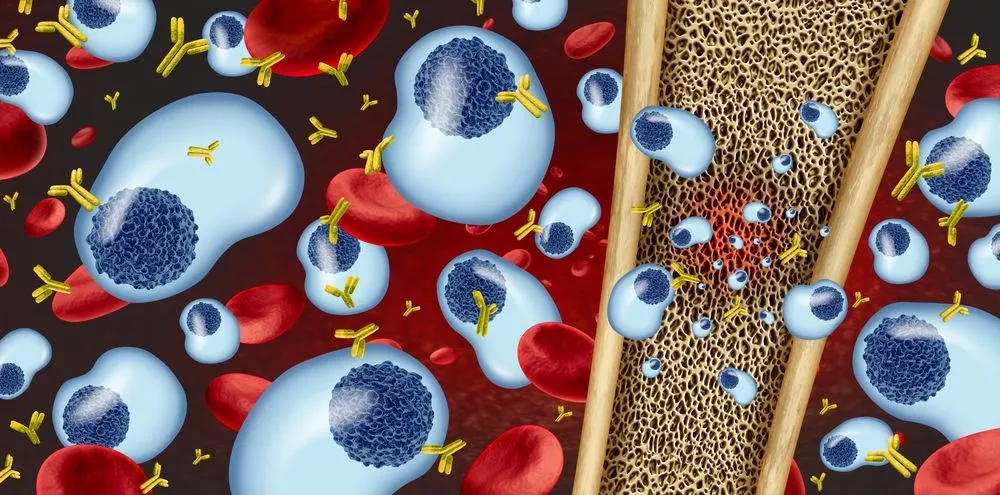What Factors Make MGUS Progress Faster?

Monoclonal gammopathy of undetermined significance (MGUS) is a condition where abnormal plasma cells produce a protein called M protein. It is not cancer, but is considered a precursor condition. It can evolve to smoldering myeloma and then multiple myeloma. Most MGUS cases can remain stable. However, identifying who may progress is important so patients receive the right monitoring or, in some cases, earlier treatment.
A recent long-term study presented at the 2025 European Hematology Association (EHA) conference offers valuable insight into risk factors in MGUS that predict disease progression.
From MGUS to malignancy: prognostic factors and clinical implications
The study followed 190 patients (61 men and 129 women) diagnosed with MGUS between 2000 and 2024. Their median age at diagnosis was 61 years and ranged from 32 to 90 years old. Researchers analyzed the type and concentration of M protein, kidney function, immune suppression (called immunoparesis), bone marrow findings, and serum free light chains (FLCs).
Most patients (68.9%) had IgG MGUS, the most common subtype. Others had IgA (7.9%), IgM (10.5%), or rarer types like biclonal MGUS (11.1%) or Bence Jones (BJ) MGUS (1.6%). Only a small group (2.6%) had an M protein concentration above 15 grams per liter, which is considered higher-risk.
What is the risk of progressing from MGUS?
Over the course of follow-up, 6.8% progressed to multiple myeloma or AL amyloidosis. Fewer people progressed to monoclonal gammopathy of renal significance (MGRS), a condition where abnormal proteins damage the kidneys, and only one person had Waldenström macroglobulinemia. The median time to progression was 40 months, but it varied widely, from just 1 year to over 17 years.
Mayo Clinic risk score helps predict progression
Each patient’s risk was evaluated using the Mayo Clinic MGUS risk model. This score considers M protein levels, FLC ratio, and the type of immunoglobulin involved.
- 55% had low-risk MGUS
- 35.4% had low-intermediate risk
- 9% had intermediate-high risk
- 0.5% had high-risk
Progression was much more likely in patients with intermediate-high and high-risk scores. In fact, 11 out of the 13 patients who progressed (85%) fell into these two categories. Patients with low or low-intermediate risk MGUS progressed much less often.
Additional risks: immunoparesis and proteinuria
The study also identified other markers linked to a higher chance of progression. Suggesting that kidney function and immune health may be important indicators of risk, in addition to traditional scoring tools.
- Immunoparesis: the weakened immune system was present in 23.1% of progressing patients but only 1.2% of those who did not progress.
- High M protein concentration: More than 15 g/L was found in 15.4% of people who progressed to other diseases, compared to just 1.7% of those who didn’t.
- 24-hour protein in urine (proteinuria): Patients who progressed had higher protein loss in urine.
Final thoughts
This study reinforces that most people with MGUS remain stable over time. But for a small group, the condition can progress. Recognizing features such as intermediate-high or high-risk scores, immunoparesis, and abnormal kidney findings (like proteinuria) can help clinicians monitor patients more closely.
If you have MGUS, consider discussing with your care team:
- What is your risk score based on current lab results?
- Do you have signs of immunoparesis or proteinuria?
- How often should your labs and kidney function be checked?
Understanding your individual risk profile can guide whether close observation or early treatment is appropriate. Stay informed and speak with your doctor about any changes in symptoms or lab results.
If you are interested in learning more, join our MGUS/Smoldering Myeloma Group to get notifications about future events.
You can also learn at your own pace from HealthTree University, by creating an account you can save courses, test your knowledge and track your progress:
MGUS HealthTree University Courses
Source:
Monoclonal gammopathy of undetermined significance (MGUS) is a condition where abnormal plasma cells produce a protein called M protein. It is not cancer, but is considered a precursor condition. It can evolve to smoldering myeloma and then multiple myeloma. Most MGUS cases can remain stable. However, identifying who may progress is important so patients receive the right monitoring or, in some cases, earlier treatment.
A recent long-term study presented at the 2025 European Hematology Association (EHA) conference offers valuable insight into risk factors in MGUS that predict disease progression.
From MGUS to malignancy: prognostic factors and clinical implications
The study followed 190 patients (61 men and 129 women) diagnosed with MGUS between 2000 and 2024. Their median age at diagnosis was 61 years and ranged from 32 to 90 years old. Researchers analyzed the type and concentration of M protein, kidney function, immune suppression (called immunoparesis), bone marrow findings, and serum free light chains (FLCs).
Most patients (68.9%) had IgG MGUS, the most common subtype. Others had IgA (7.9%), IgM (10.5%), or rarer types like biclonal MGUS (11.1%) or Bence Jones (BJ) MGUS (1.6%). Only a small group (2.6%) had an M protein concentration above 15 grams per liter, which is considered higher-risk.
What is the risk of progressing from MGUS?
Over the course of follow-up, 6.8% progressed to multiple myeloma or AL amyloidosis. Fewer people progressed to monoclonal gammopathy of renal significance (MGRS), a condition where abnormal proteins damage the kidneys, and only one person had Waldenström macroglobulinemia. The median time to progression was 40 months, but it varied widely, from just 1 year to over 17 years.
Mayo Clinic risk score helps predict progression
Each patient’s risk was evaluated using the Mayo Clinic MGUS risk model. This score considers M protein levels, FLC ratio, and the type of immunoglobulin involved.
- 55% had low-risk MGUS
- 35.4% had low-intermediate risk
- 9% had intermediate-high risk
- 0.5% had high-risk
Progression was much more likely in patients with intermediate-high and high-risk scores. In fact, 11 out of the 13 patients who progressed (85%) fell into these two categories. Patients with low or low-intermediate risk MGUS progressed much less often.
Additional risks: immunoparesis and proteinuria
The study also identified other markers linked to a higher chance of progression. Suggesting that kidney function and immune health may be important indicators of risk, in addition to traditional scoring tools.
- Immunoparesis: the weakened immune system was present in 23.1% of progressing patients but only 1.2% of those who did not progress.
- High M protein concentration: More than 15 g/L was found in 15.4% of people who progressed to other diseases, compared to just 1.7% of those who didn’t.
- 24-hour protein in urine (proteinuria): Patients who progressed had higher protein loss in urine.
Final thoughts
This study reinforces that most people with MGUS remain stable over time. But for a small group, the condition can progress. Recognizing features such as intermediate-high or high-risk scores, immunoparesis, and abnormal kidney findings (like proteinuria) can help clinicians monitor patients more closely.
If you have MGUS, consider discussing with your care team:
- What is your risk score based on current lab results?
- Do you have signs of immunoparesis or proteinuria?
- How often should your labs and kidney function be checked?
Understanding your individual risk profile can guide whether close observation or early treatment is appropriate. Stay informed and speak with your doctor about any changes in symptoms or lab results.
If you are interested in learning more, join our MGUS/Smoldering Myeloma Group to get notifications about future events.
You can also learn at your own pace from HealthTree University, by creating an account you can save courses, test your knowledge and track your progress:
MGUS HealthTree University Courses
Source:

about the author
Jimena Vicencio
Jimena is an International Medical Graduate and a member of the HealthTree Writing team. Currently pursuing a bachelor's degree in journalism, she combines her medical background with a storyteller’s heart to make complex healthcare topics accessible to everyone. Driven by a deep belief that understanding health is a universal right, she is committed to translating scientific and medical knowledge into clear, compassionate language that empowers individuals to take control of their well-being.
More on Navigating Your Health
Trending Articles
Get the Latest Blood Cancer Updates, Delivered to You.
By subscribing to the HealthTree newsletter, you'll receive the latest research, treatment updates, and expert insights to help you navigate your health.
Together we care.
Together we cure.
3x Faster.











